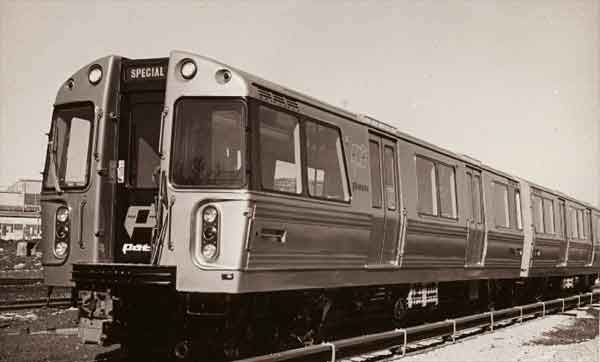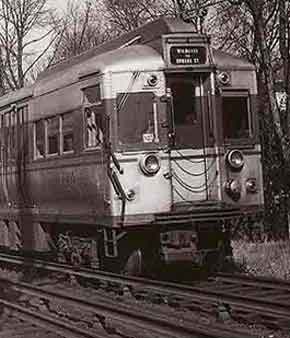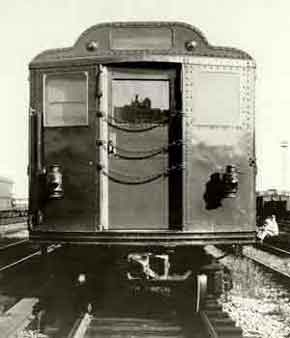
New York's Lost Transit Legacy Page 5

Far from its
future, the Bluebird spends its last days in the
Lutheran Yard of the BMT Myrtle Avenue Line in 1956. A few of the elevated
gates cars it was intended to replace sit nearby. They actually lasted in
service two years longer than the Bluebird.
Paul Matus Collection
Art Deco and
Advanced Technology
Having “solved” the future of its
elevated system, the BMT could have been expected to rest on its laurels.
Though 25 multi-unit cars had been ordered and delivered, there was more
innovation to come. Working with the Presidents’ Conference Committee
(PCC) of the electric railway industry, the BMT was a major force in
development of PCC technology, which revolutionized electric rail transit
worldwide, though it only slowed its U.S.
decline.
In 1936, the BMT’s contribution to
PCC technology was recognized as Brooklyn received the very first fleet of
PCC streetcars.
The BMT believed it could extend PCC technology and
principles to a subway-elevated car. Not only would the technological advances
of PCC equipment advance the state of the rapid transit art, it promised to
introduce major economies of scale as identical advanced components could be
ordered for streetcars and rapid transit cars alike. In 1939 it introduced the
pilot unit of the Bluebird. The BMT
used a new term to describe the three-section Bluebird: “compartment car.”
Inside and out, the Bluebird’s art deco design was a gem of modernity
and comfort. Its list of advanced features was lengthy. So impressed was the BMT and
the public with the new car that a fleet of 50 was ordered.
The End of Innovation
New York City politics was not
standing still, however. Mayor Fiorello LaGuardia, who had taken office in
1933, was no friend of streetcars, of elevated lines, or of private
ownership of transit. He pressed relentlessly for “Unification,” the City
takeover of the BMT and IRT. The IRT was happy to go out of business but
the BMT fought almost to the last.
On June 2, 1940, the BMT was
in City hands. Of the fleet of 50 Bluebird
cars ordered, five
were under construction by the Clark Equipment Company. It was the City
that took delivery. The cars ran, but theirs was a lonely existence, for
the rest of the order was cancelled. The stolid Board of Transportation
was in the driver’s seat.
After the Fall
After taking over the private companies, not only did the innovations
of the BMT end, but the City lost its taste for subway building. The IND
“Second System” of 1929 remains unbuilt. The private lines that attracted IND
competition were abandoned, several immediately and more as the years went on.
Major improvements have been proposed periodically and in 1950 a $500M bond
issue was passed, ostensibly to build the Second Avenue Subway. But despite
revived plans from time to time, including an ambitious program proposed in
1968, the Second Avenue Subway remains unbuilt and most other plans are
pipedreams.
PCC technology came to be used in other cities’ rapid
transit systems, but not New York’s. During the lowest days of rail transit in
the U.S., in the ‘50s and ‘60s, most new subway equipment built in the U.S. was
built for New York, due to the sheer size of the system. New York’s car design
department specified how the equipment was to be built, down to the last nut
and bolt. Not only were these designs conservative to say the least, but so
elemental an improvement as the use of stainless steel car bodies was precluded
until the Budd Company, builder of the Zephyr,
won the R32 BMT-IND contract in 1964 by underbidding the other builders who
offered LAHT (non-stainless) steel construction. Thirty-five years later, these
R32 cars are among the most durable in the fleet. After that order, the TA
specified stainless steel in their new car specifications. One might say they
innovated in spite of themselves.
New York,
which with its BMT was the national leader in transit, had become the
industry’s albatross.
|
5 |
|
| |
|
|
|
The Third Rail and The Third Rail logo are trademarks of The Composing Stack Inc.
Return to The Third Rail Online Home
Return to
rapidtransit.net Home
Everything on this site is copyright © 1999-2000 by The Composing
Stack Inc., except as otherwise noted.
Materials
with other copyrights are used by permission.
All
rights reserved
Last updated Febraury 26, 2000


